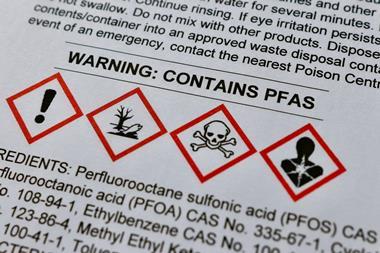An analysis of foetal liver tissue offers new insight into the metabolic effects of polyfluoroalkyl substances (PFAS). The findings show that exposure to these ‘forever chemicals’ alters lipid metabolism in unborn children, and could increase the risk of metabolic disease later in life.
While PFAS are associated with negative health impacts, the metabolic pathways linking PFAS exposure to human disease are unclear, and most studies into these effects have focused on exposure in adults. Scientists from the UK and Sweden have now investigated the metabolic effects of PFAS in the foetal liver tissue.
The researchers collected samples of liver tissue from 78 foetuses that had been voluntarily aborted between 12 and 19 weeks when they were considered to be healthy. The team performed mass spectrometry-based metabolomic analyses and found PFAS in most of the samples. They then performed correlation analysis on this data to see how PFAS exposure might affect foetal metabolism.
‘We already knew that PFAS are transferred from the mother to the foetus so we were not surprised to detect that. But that they have such a strong impact on the metabolic pathways – it was much, much stronger than what we were expecting,’ says Tuulia Hyötyläinen, from Örebro University in Sweden.
The team saw a positive association between PFAS and a cholestanoid known as C4, which Hyötyläinen explains is a marker for bile acid metabolism. ‘If bile acids are synthesised from cholesterol in the liver, then C4 is a marker of this synthesis,’ she says. As C4 was present in higher concentrations in the PFAS-exposed samples, the researchers believe that PFAS is likely to impact lipid metabolism in the liver.
The team also saw that the more PFAS in the liver, the fewer polyunsaturated fats (PUFAs). PUFAs are key building blocks for brain development and are responsible for the proper functioning of neurons, synapses, and neuronal communication. ‘Several other studies have shown that, in adults, PFAS are linked to reduced amounts of PUFAs,’ notes Hyötyläinen. She explains that a reduction in PUFAs in the liver could have a negative effect on an infant’s neurological development.
These effects are clearly visible at a critical stage in human development
Dimitri Abrahamsson, New York University
Hyötyläinen points out that numerous epidemiological studies have examined PFAS in infants and followed their progression to adulthood. She notes that the countries with the highest exposure levels are mainly in Asia, particularly China, where increased rates of metabolic diseases have been observed. This suggests that PFAS may be contributing to these health problems, she adds.
‘This is a great study that underlines the impacts that PFAS exposures are having on lipid metabolism,’ says Dimitri Abrahamsson from New York University in the US, who was not involved in the project. ‘Especially important is that these effects are clearly visible even in foetuses, which is a critical stage in human development.’
In his own research, Abrahamsson has also seen strong links between PFAS and fatty acids in the blood of pregnant mothers and in the umbilical cord. ‘The fact that these effects are seen in two independent studies from two distinct populations shows that PFAS exposures and their effects on human metabolism happen on a global scale,’ he says.
References
T Hyötyläinen et al, Lancet Planet. Health, 2024, 8 (DOI: 10.1016/S2542-5196(23)00257-7)

















No comments yet